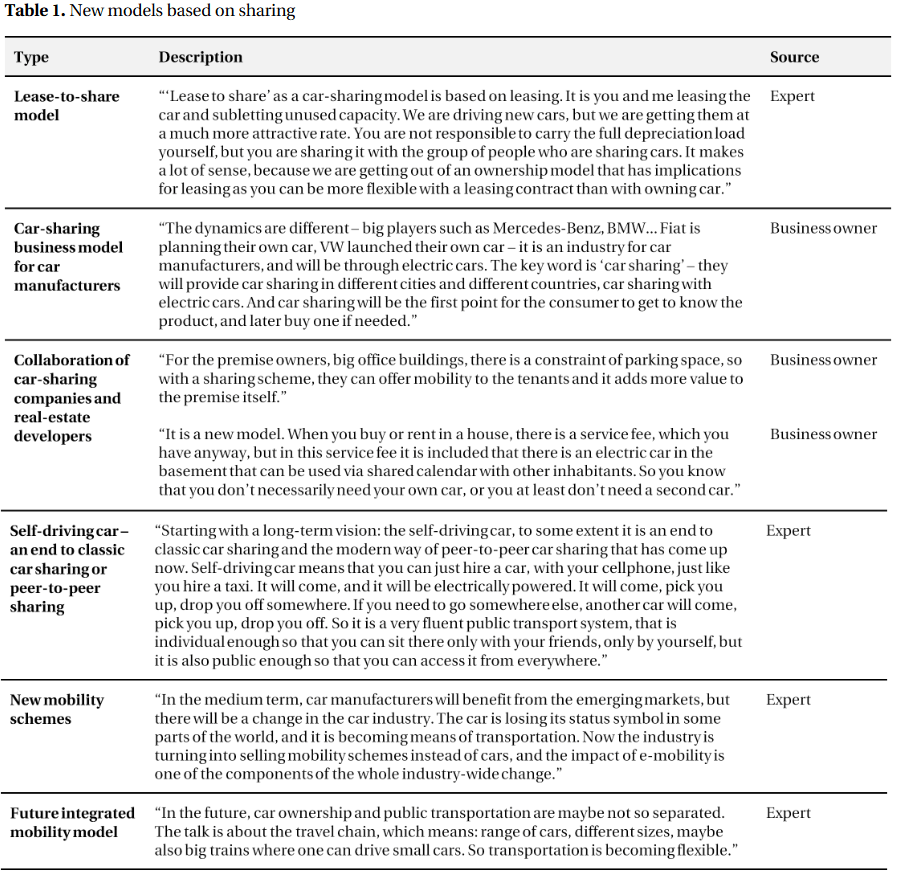By Olga Novikova, Technology Innovation Management Review, 2017
The sharing economy is an emerging phenomenon that shapes the cultural, economic, and social landscape of our modern world. With variations of the concept of the sharing economy emerging in so many fields, the area of shared mobility – the shared use of a motor vehicle, bicycle, or other mode that enables travellers to gain short-term access to transportation modes on an on-demand basis – has developed as the forerunner of the transformation to be expected in other areas. This article examines how the sphere of personal mobility has been affected by the growth of sharing economy. It contributes to the growing body of shared mobility literature by uncovering innovative mobility-based models that represent solutions on the intersection of shared mobility, physical infrastructure, and integrated-mobility schemes (…)

Mobility in the Sharing Economy
One of the perhaps most recognized and widespread applications of the sharing economy has emerged in the area of personal mobility through car sharing (Botsman & Rogers, 2010; Cohen & Kietzman, 2014). As with sharing itself, car sharing is not a new phenomenon. Car sharing emerged in the 1950s when membership was primarily motivated by economics (Shaheen et al., 1998), and it has since continued its worldwide growth (Shaheen & Cohen, 2007). With car sharing, individuals gain the benefits of using private cars without the costs and responsibilities of car ownership (Shaheen et al., 1998). Thus, instead of owning one or more vehicles, a household accesses a fleet of vehicles on an as-needed basis. Car sharing may be thought of as organized recurring short-term car rental. Individuals gain access to a car-sharing service by joining organizations that maintain a fleet of cars in a network of vehicle locations. Generally, participants pay a modest fixed charge plus a usage fee each time they use a vehicle (Shaheen et al, 1998; Shaheen & Cohen, 2013). The impacts of car sharing can be categorized as environmental, land use, social effects, and transportation (Shaheen & Cohen, 2013). Several possible typologies of car sharing have been identified (Bauwens et al., 2012; Cohen & Kietzman, 2014; Shaheen et al., 1998). For example, Bauwens (2012) differentiates between peer-to-peer car sharing, business-to-consumer car sharing, and non-profit cooperatives. Peer-to-peer (or consumer-to-consumer) car sharing implies that the fleet of cars is owned by a community. The marketplace then matches cars that are available by the owners with the prospective drivers willing to rent them. Companies such as Turo (formerly RelayRides), Getaround, and JustShareIt offer examples of peer-to-peer car sharing. Business-to-consumer car sharing means that a company owns a fleet of cars and facilitates the sharing among members. Auto manufacturers (e.g., BMW, Peugeot, Daimler), rental brands (e.g., Hertz, WeCar), and carsharing brands (e.g., Zip-car, StattAuto, GoGet) offer examples of business-to-consumer car sharing. Nonprofit cooperatives (or public initiatives) involve a local organization or community that facilitates car sharing with the goal of changing driving habits over making a profit. Organizations such as City Car Share, PhillyCarShare, and Autolib are examples of such initiatives. Another case of sharing economy that shapes the personal mobility space is ride sharing (or ride hailing –vehicle owners allowing other passengers to ride in the same vehicle to and from the same or similar destinations), with Uber being the most prominent example of a platform enabling peer-to-peer transactions (Cohen & Kietzmann, 2014). Similarly, various dynamic ride-share systems aim to bring together travellers with similar schedules and itineraries on short notice. As Agatz and colleagues (2012) note, new dynamic ride-sharing systems have the potential to provide significant societal and environmental benefits by reducing the number of cars used for personal travel and improving the utilization of available seat capacity. Overall, three factors seem to contribute to the ongoing worldwide growth in shared-use vehicle membership: i) cost savings; ii) convenience of locations, use, and access; and iii) environmental awareness (Shaheen & Cohen (2013).

Please, read the full article at: http://www.timreview.ca/sites/default/files/article_PDF/Novikova_TIMReview_August2017.pdf















